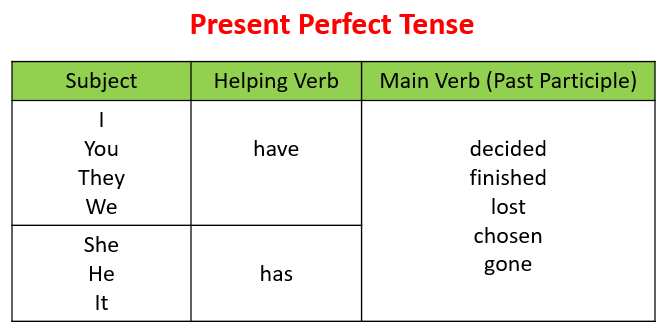PRESENT PERFECT TENSE

Present Perfect Tense:-The Tense which shows a completed
event in present time is called present perfect tense.
वह Tense जो वर्तमान समय में किसी पूर्ण कार्य को दर्शाता
है, उसे present perfect tense कहते है |
Identification:-वाक्य के अन्त में या है, ये है, यी
है तथा चुका है, चुके है, चुकी है आदि पाया जाता है |
Stru:- S+have/has+V3+O+R.M.
Rule:-1. We use ‘have’ with I,They,We,You and two or
more than two name and ‘has’ with He,She,It and any single name and then use V3.
I
We
They
You - have
We
and
Two
or more than two name
He
She
It - has
And
Any single name

2.In Negative sentence, We use ‘not’ after the have/has.
3.In Interrogative sentence, We use have/has before the
subject.
4.In Interrogative Negative sentence, We use ‘not’ after
the subject instead of this We also use short form of have not(haven’t)/has
not(hasn’t).
Have not = haven’t
Has not = hasn’t
5. What is V3?
Ø V3 is also called third form of verb.
V1 V2 V3
Go went gone
Come came come
Play played played
Write wrote written
Ask asked asked
Cut cut cut
Hit hit hit etc.
E.g. of Present Perfect
Tense:-
AFFIRMATIVE
Stru:-S+have/has+V3+O+R.M.
1.मैंने उसे सूचित कर दिया है |
I have
informed him.
2.चाची चाय पी चुकी है |
Aunti has taken tea.
3. मेरी माँ
मंदिर गयी है |
My
Mother has gone to temple.
4.वे लोग लिख चुके है |
They
have written.
5.वे लोग दो बार मुझसे पुछे है |
They
have asked to me two times.
NEGATIVE
Stru:- S+have/has+not+V3+O+R.M.
1.मैंने
उसे सुचित नहीं किया है |
I have
not/haven’t informed him.
2.चाची चाय
नहीं पी चुकी है |
Aunti has
not/hasn’t taken tea.
3.मेरी माँ मंदिर नहीं गयी है |
My Mother has
not/hasn’t gone to temple.
4.वे लोग
नहीं लिख चुके है |
They have
not/haven’t written.
5.वे लोग दो बार मुझसे नहीं पुछे है |
They have
not/haven’t asked to me two times.
INTERROGATIVE
Stru:-Have/Has+S+V3+O+R.M.
1.क्या मैंने उसे सुचित किया है ?
Have I
informed him?
2.क्या चाची चाय पी चुकी है
?
Has Tanni
Aunti taken tea?
3.क्या मेरी माँ मंदिर गयी
है ?
Has My Mother
gone to temple?
4.क्या वे लोग लिख चुके है
?
Have They
written?
5.क्या वे लोग दो बार मुझसे
पुछे है ?
Have They
asked to me two times?
INTERROGATIVE NEGATIVE
Stru:-Have/Has+S+not+V3+O+R.M.
1.क्या मैंने उसे सुचित
नहीं किया है ?
Have I not
informed him?/ Haven’t I informed him?
2.क्या चाची चाय नहीं पी
चुकी है ?
Has Tanni
Aunti not taken tea?/Hasn’t Tanni Aunti
taken tea?
3.क्या मेरी माँ मंदिर नहीं
गयी है ?
Has My Mother not gone to
temple?/ Hasn’t My Mother gone to temple?
4.क्या वे लोग लिख नहीं
चुके है ?
Have They not
written?/ Haven’t They written?
5.क्या वे लोग दो बार मुझसे
नहीं पुछे है ?
Have They not
asked to me two times?/Haven’t They asked me two times?
W-H QUESTIONS
Stru:- W-H Que+have/has+not(if
require)V3+O+R.M.
1.मैंने उसे क्यों सुचित नहीं किया है ?
Why have I
informed him?
2.चाची कब चाय पी चुकी है ?
When has
Aunti taken tea?
3.मेरी माँ कौन मंदिर गयी है
?
Who has My
Mother gone to temple?
4.वे लोग कब लिख चुके है ?
When have
They written?
5.वे लोग कहाँ दो बार मुझसे
पुछे है ?
Where have
They asked to me two times?



Very good post, thank you.Visit our website.
ReplyDeletePattachitra painting of Jagannath Wall crafted
Order Handicrafts Product
Handicrafts Product Online